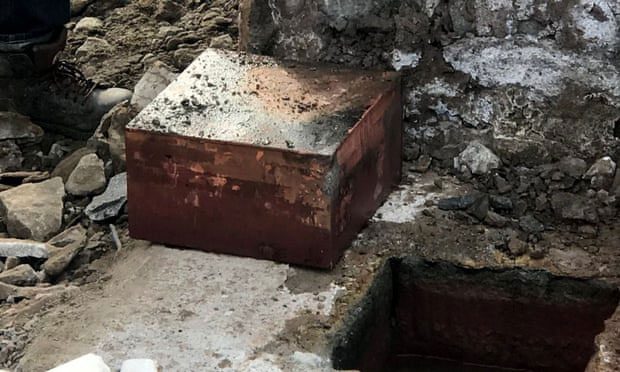On December 27, workers dismantling the statue of General Robert E. Lee discovered a “time capsule”, also known as a time box, believed to have been buried 130 years ago. Robert E. Lee (1807 – 1870) was a Confederate general and commander of the Southern army during the American Civil War (1861-1865), representing the opposition to the abolition of slavery.

The time capsule discovered during the dismantling of the statue of General Robert E. Lee. (Photo: AFP)
This is the second time capsule to be excavated at this location. On Twitter, Virginia Governor Ralph Northam wrote: “They found it (the time capsule). This could be the time capsule everyone has been searching for.” Governor Northam’s post included an image of the newly found copper box.
According to an 1887 article, a time capsule hidden in the base of the statue of General Robert E. Lee contained artifacts such as bullets, Confederate currency, maps, a rare photograph of the assassinated U.S. President Abraham Lincoln in his coffin, and other items. Conservators opened a shoebox-sized container found in the stone pedestal of the statue last week, but it was clearly not the time capsule mentioned in the 1887 article.
The first discovered box contained three water-damaged books, including a yearbook from 1875, a photograph wrapped in a waterlogged cloth, and a coin. The items appeared to be mementos left for posterity by some of the workers who erected the statue. The newly found time capsule is twice the size of the first. Governor Northam stated that archaeologists will study this time capsule.
The statue of General Robert E. Lee in Richmond, Virginia, is among the Confederate monuments supporting slavery that have been dismantled in recent months. Last year, this monument became the focal point of protests against racial discrimination following the police brutality that led to the death of African American George Floyd in Minnesota.
The statue of General Robert E. Lee, erected in 1890, is one of hundreds of monuments honoring the Confederacy (which consisted of 11 states supporting slavery during the American Civil War) still present across the United States. They are viewed as symbols of racism and reminders of the history of slavery.





















































